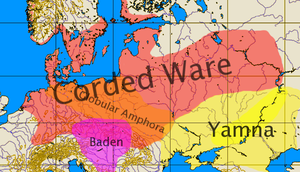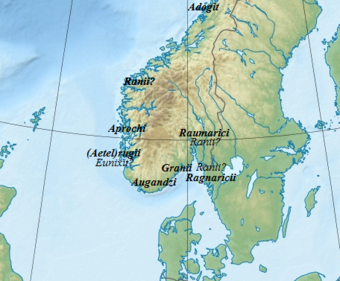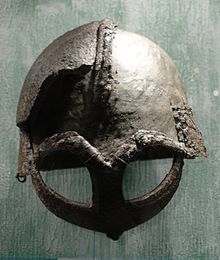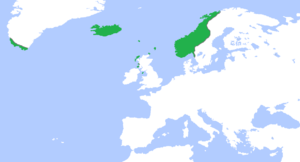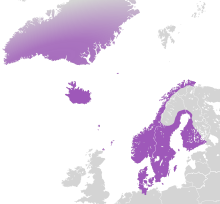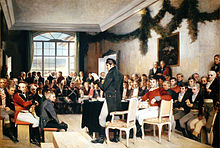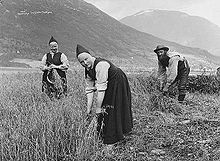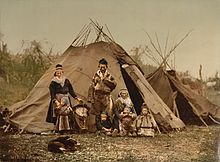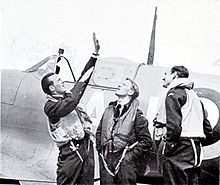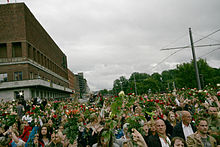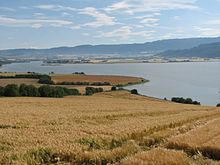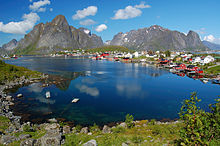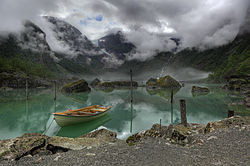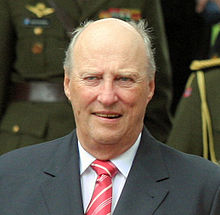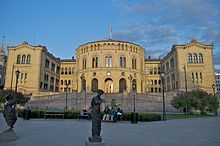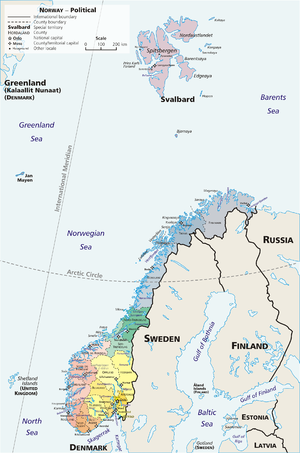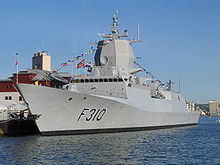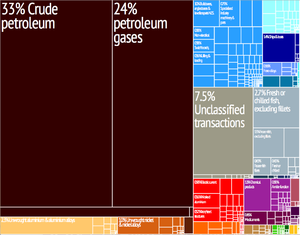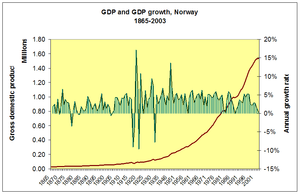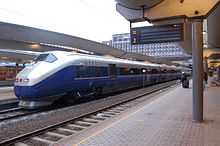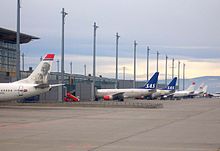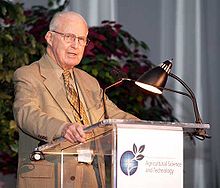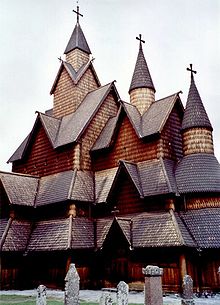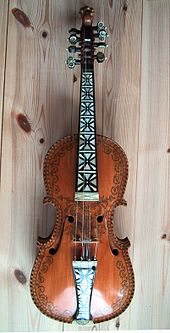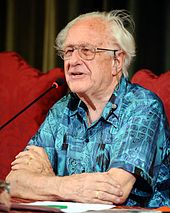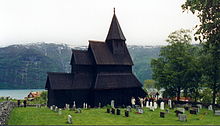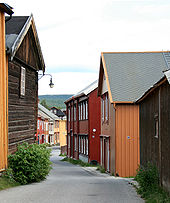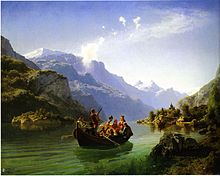
Norway
Background to the schools Wikipedia
This selection is made for schools by a children's charity read more. Sponsoring children helps children in the developing world to learn too.
Kingdom of Norway
|
||||||
|---|---|---|---|---|---|---|
|
||||||
Motto:
|
||||||
Anthem:
|
||||||
| Capital and largest city |
Oslo 59°56′N 10°41′E |
|||||
| Official languages | Norwegian ( Bokmål / Nynorsk) | |||||
| Recognised regional languages |
|
|||||
| Ethnic groups |
|
|||||
| Demonym | Norwegian | |||||
| Government | Unitary parliamentary constitutional monarchy | |||||
| - | King | King Harald V | ||||
| - | Prime Minister | Jens Stoltenberg ( AP) | ||||
| - | President of the Storting | Dag Terje Andersen (AP) | ||||
| - | Chief Justice | Tore Schei | ||||
| - | Current coalition | Red-Green Coalition | ||||
| Legislature | Storting | |||||
| Establishment | ||||||
| - | Unification | 872 | ||||
| - | Constitution | 17 May 1814 | ||||
| - | Dissolution of union with Sweden |
7 June 1905 | ||||
| - | Restoration from German occupation |
8 May 1945 | ||||
| Area | ||||||
| - | Total | 385,186 km2 ( 61sta) 148,720 sq mi |
||||
| - | Water (%) | 5.2b | ||||
| Population | ||||||
| - | 2013 census | 5,063,709 | ||||
| - | Density | 15.5/km2 ( 213th) 35/sq mi |
||||
| GDP ( PPP) | 2011 estimate | |||||
| - | Total | $265.911 billion | ||||
| - | Per capita | $53,470 | ||||
| GDP (nominal) | 2011 estimate | |||||
| - | Total | $483.650 billion | ||||
| - | Per capita | $97,254 | ||||
| Gini (2000) | 25.8 low · 5th |
|||||
| HDI (2013) | very high · 1st |
|||||
| Currency | Norwegian krone ( NOK) |
|||||
| Time zone | CET ( UTC+1) | |||||
| - | Summer ( DST) | CEST ( UTC+2) | ||||
| Date format | dd.mm.yyyy | |||||
| Drives on the | right | |||||
| Calling code | +47 | |||||
| ISO 3166 code | NO | |||||
| Internet TLD | .noc | |||||
| a. | Includes Svalbard and Jan Mayen. (Without these two areas, the area of Norway is 323,802 km2, placing it 67th in the world.) | |||||
| b. | This percentage is for the mainland, Svalbard, and Jan Mayen. This percentage counts glaciers as "land". It's calculated as 19,940.14/(365,246.17+19,940.14). | |||||
| c. | Two more TLDs have been assigned, but to date not used: .sj for Svalbard and Jan Mayen; .bv for Bouvet Island. | |||||
Norway ( / ˈ n ɔr w eɪ /; Norwegian: ![]() Norge ( Bokmål) or
Norge ( Bokmål) or ![]() Noreg ( Nynorsk)), officially the Kingdom of Norway, is a Scandinavian unitary constitutional monarchy whose territory comprises the western portion of the Scandinavian Peninsula, Jan Mayen, the Arctic archipelago of Svalbard and the subantarctic Bouvet Island. Norway has a total area of 385,252 square kilometres (148,747 sq mi) and a population of about 5 million. It is the second least densely populated country in Europe. The country shares a long border with Sweden ( 1,619 km long) that it is the longest uninterrupted border within both Europe and Schengen Area; it is also bordered by Finland and Russia to the north-east; in its south Norway borders the Skagerrak Strait across from Denmark. It shares maritime borders with Russia by the Barents sea, Greenland, Faroe Islands and Iceland by the Norwegian Sea, Sweden, Denmark and United Kingdom by the North Sea. The capital city of Norway is Oslo. Norway's extensive coastline, facing the North Atlantic Ocean and the Barents Sea, is home to its famous fjords.
Noreg ( Nynorsk)), officially the Kingdom of Norway, is a Scandinavian unitary constitutional monarchy whose territory comprises the western portion of the Scandinavian Peninsula, Jan Mayen, the Arctic archipelago of Svalbard and the subantarctic Bouvet Island. Norway has a total area of 385,252 square kilometres (148,747 sq mi) and a population of about 5 million. It is the second least densely populated country in Europe. The country shares a long border with Sweden ( 1,619 km long) that it is the longest uninterrupted border within both Europe and Schengen Area; it is also bordered by Finland and Russia to the north-east; in its south Norway borders the Skagerrak Strait across from Denmark. It shares maritime borders with Russia by the Barents sea, Greenland, Faroe Islands and Iceland by the Norwegian Sea, Sweden, Denmark and United Kingdom by the North Sea. The capital city of Norway is Oslo. Norway's extensive coastline, facing the North Atlantic Ocean and the Barents Sea, is home to its famous fjords.
Two centuries of Viking raids tapered off following the adoption of Christianity by King Olav Tryggvason in 994. A period of civil war ended in the 13th century when Norway expanded its control overseas to parts of Britain, Ireland, Iceland, and Greenland. Norwegian territorial power peaked in 1265, but competition from the Hanseatic League and the spread of the Black Death weakened the country. In 1380, Norway was absorbed into a union with Denmark that lasted more than four centuries. In 1814, Norwegians resisted the cession of their country to Sweden and adopted a new constitution. Sweden went to war with Norway but agreed to let Norway keep its constitution in return for accepting the union under a Swedish king. Rising nationalism throughout the 19th century led to a 1905 referendum granting Norway independence. Although Norway remained neutral in World War I, it suffered heavy losses to its shipping. Norway proclaimed its neutrality at the outset of World War II, but was nonetheless occupied for five years by the Third Reich. In 1949, neutrality was abandoned and Norway became a founding member of NATO. Discovery of oil and gas in adjacent waters in the late 1960s boosted Norway's economic fortunes. In referenda held in 1972 and 1994, Norway rejected joining the European Union. Key domestic issues include immigration and integration of ethnic minorities, maintaining the country's extensive social safety net with an aging population, and preserving economic competitiveness.
King Harald V is Norway's head of state and Jens Stoltenberg is its prime minister. It has administrative subdivisions on two levels known as counties ( fylke) and municipalities ( kommuner). The Sámi people have a certain amount of self-determination and influence over traditional territories through the Sámi Parliament and the Finnmark Act. Although having rejected European Union membership in two referenda, Norway maintains close ties with the union and its member countries, as well as with the United States. Norway participates with United Nations forces in international missions, notably in Afghanistan, Kosovo, Sudan and Libya. Norway is a founding member of the United Nations, NATO, the Council of Europe, and the Nordic Council; a member of the European Economic Area, the WTO, and the OECD; and is also a part of the Schengen Area.
Norway has extensive reserves of petroleum, natural gas, minerals, lumber, seafood, fresh water, and hydropower. The country has the fourth-highest per capita income in the world. On a per-capita basis, it is the world's largest producer of oil and natural gas outside the Middle East, and the petroleum industry accounts for around a quarter of the country's gross domestic product. The country maintains a welfare model with universal health care, subsidized higher education, and a comprehensive social security system. From 2001 to 2006, and then again from 2009 through 2011, Norway has had the highest human development index ranking in the world. In 2011, Norway also had the highest ranking on the Democracy Index and the Legatum Prosperity Index. According to UNDP, Norway is the world's best country. Forbes rank Norway #4 in their list The World's richest countries, which compare countries by GDP. Norway was the first independent country to introduce women's suffrage in 1913.
Etymology
Modern etymologists believe the country's name means "the northward route" (the "way north" or the "north way"), which in Old Norse would have been nor veg or *norð vegr. The Old Norse name for Norway was Nóregr, the Anglo-Saxon Norþ weg and mediaeval Latin Northvegia. The official name of the Kingdom of Norway in Bokmål is "Kongeriket Norge", while in Nynorsk it is "Kongeriket Noreg", both only a couple of letters removed from the original "northern way": Nor(d)-(v)eg.
Ohthere of Hålogaland around 890 AD distinguished "Norwegians" ("nordmenn", the people of Norvegr) from Sami people and Danes. While he identified the Sami people by their nomadic way of life, Danes he identified geographically or politically. According to Ohthere, "Danes" dominated Skagerrak and Kattegat, the bodies of water separating present day Denmark from the Scandinavian peninsula. "Norwegians" on the other hand lived on the North Sea and Atlantic coasts, and were connected to the islands of the North Atlantic. Ohthere's Norway covered a much smaller area than present day Norway.
History
Prehistory
The first inhabitants were the Ahrensburg culture (11th to 10th millennia BC) which was a late Upper Paleolithic culture during the Younger Dryas, the last spell of cold at the end of the Weichsel glaciation. The culture is named after village of Ahrensburg, 25 km (15.53 mi) northeast of Hamburg in the German state of Schleswig-Holstein where wooden arrow shafts and clubs have been excavated. The earliest traces of human occupation in Norway are found along the coast, where the huge ice shelf of the last ice age first melted between 11,000 and 8,000 BC. The oldest finds are stone tools dating from 9,500 to 6,000 BC, discovered in Finnmark ( Komsa culture) in the north and Rogaland ( Fosna culture) in the southwest. However, theories about two altogether different cultures (the Komsa culture north of the Arctic Circle being one and the Fosna culture from Trøndelag to Oslo Fjord being the other) were rendered obsolete in the 1970s. More recent finds along the entire coast revealed to archaeologists that the difference between the two can simply be ascribed to different types of tools and not to different cultures. Coastal fauna provided a means of livelihood for fishermen and hunters, who may have made their way along the southern coast about 10,000 BC when the interior was still covered with ice. It is now thought that these so-called "Arctic" peoples came from the south and followed the coast northward considerably later. Some may have come along the ice-free coast of the Kola Peninsula, but the evidence of this is still poor.
In the southern part of the country are dwelling sites dating from about 5,000 BC. Finds from these sites give a clearer idea of the life of the hunting and fishing peoples. The implements vary in shape and mostly are made of different kinds of stone; those of later periods are more skillfully made. Rock carvings (i. e. petroglyphs) have been found, usually near hunting and fishing grounds. They represent game such as deer, reindeer, elk, bears, birds, seals, whales, and fish (especially salmon and halibut), all of which were vital to the way of life of the coastal peoples. The carvings at Alta in Finnmark, the largest in Scandinavia, were made at sea level continuously from 4,200 to 500 BC and mark the progression of the land as it rose from the sea after the last ice age ( Rock carvings at Alta).
Bronze Age
Between 3000 and 2500 BC new settlers ( Corded Ware culture) arrived in eastern Norway. They were Indo-European farmers who grew grain and kept cows and sheep. The hunting-fishing population of the west coast was also gradually replaced by farmers, though hunting and fishing remained useful secondary means of livelihood.
From about 1500 BC bronze was gradually introduced, but the use of stone implements continued; Norway had few riches to barter for bronze goods, and the few finds consist mostly of elaborate weapons and brooches that only chieftains could afford. Huge burial cairns built close to the sea as far north as Harstad and also inland in the south are characteristic of this period. The motifs of the rock carvings differ from those typical of the Stone Age. Representations of the Sun, animals, trees, weapons, ships, and people are all strongly stylized, probably as fertility symbols connected with the religious ideas of the period.
Iron Age
Little has been found dating from the early Iron Age (the last 500 years BC). The dead were cremated, and their graves contain few burial goods. During the first four centuries AD the people of Norway were in contact with Roman-occupied Gaul. About 70 Roman bronze cauldrons, often used as burial urns, have been found. Contact with the civilized countries farther south brought a knowledge of runes; the oldest known Norwegian runic inscription dates from the 3rd century. At this time the amount of settled area in the country increased, a development that can be traced by coordinated studies of topography, archaeology, and place-names. The oldest root names, such as nes, vik, and bø ("cape," "bay," and "farm"), are of great antiquity, dating perhaps from the Bronze Age, whereas the earliest of the groups of compound names with the suffixes vin ("meadow") or heim ("settlement"), as in Bjorgvin (Bergen) or Saeheim (Seim), usually date from the 1st century AD.
Migration Age
The destruction of the Western Roman Empire by the Germanic tribes (5th century) is characterized by rich finds, including chieftains' graves containing magnificent weapons and gold objects. Hill forts were built on precipitous rocks for defense. Excavation has revealed stone foundations of farmhouses 60 to 90 feet (18 to 27 metres) long—one even 150 feet (46 metres) long—the roofs of which were supported on wooden posts. These houses were family homesteads where several generations lived together, with people and cattle under one roof. From this period and later (600–800), nascent communities can be traced. Defense works require cooperation and leadership, so petty states of some kind with a defense and administrative organization must have existed.
These states were based on either clans or tribes (e.g., the Horder of Hordaland in western Norway). By the 9th century each of these small states had things, or tings (local or regional assemblies), for negotiating and settling disputes. The thing meeting places, each eventually with a horg (open-air sanctuary) or a hov (temple; literally "hill"), were usually situated on the oldest and best farms, which belonged to the chieftains and wealthiest farmers. The regional things united to form even larger units: assemblies of deputy yeomen from several regions. In this way, the lagting (assemblies for negotiations and lawmaking) developed. The Gulating had its meeting place by Sognefjord and may have been the centre of an aristocratic confederation along the western fjords and islands called the Gulatingslag. The Frostating was the assembly for the leaders in the Trondheimsfjord area; the earls Jarls of Lade, near Trondheim, seem to have enlarged the Frostatingslag by adding the coastland from Romsdalsfjord to the Lofoten Islands. A lagting developed in the area of Lake Mjøsa in the east and eventually established its meeting place at Eidsvoll, becoming known as the Eidsivating. The area around Oslofjord, although at times closely tied to Denmark, developed a lagting—with its meeting place at Sarpsborg called the Borgarting.
Viking Age
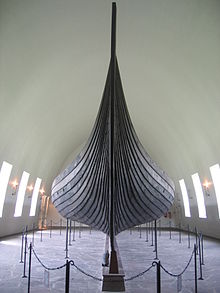
The Viking Age was characterized by expansion and emigration by Viking seafarers. According to tradition, Harald Fairhair (Harald Hårfagre) unified them into one in 872 after the Battle of Hafrsfjord in Stavanger, thus becoming the first king of a united Norway. (The date of 872 may be somewhat arbitrary. In fact, the actual date may be just prior to 900). Harald's realm was mainly a South Norwegian coastal state. Harald Fairhair ruled with a strong hand and, according to the sagas, many Norwegians left the country to live in Iceland, the Faroe Islands, Greenland, and parts of Britain and Ireland. The modern-day Irish cities of Dublin, Limerick, and Waterford were founded by Norwegian (and Danish) settlers. Norse traditions were slowly replaced by Christian ones in the 10th and 11th centuries. This is largely attributed to the missionary kings Olav Tryggvasson and St. Olav. Haakon the Good was Norway's first Christian king, in the mid-10th century, though his attempt to introduce the religion was rejected. Born sometime in between 963–969, Olav Tryggvasson set off raiding in England with 390 ships. He attacked London during this raiding. Arriving back in Norway in 995, Olav landed in Moster. There he built a church which became the first Christian church ever built in Norway. From Moster, Olav sailed north to Trondheim were he was acclaimed King of Norway by the Eyrathing in 995.
Feudalism never really developed in Norway and Sweden, as it did in the rest of Europe. However, the administration of government took on a very conservative feudal character. The Hanseatic League forced the royalty to cede to them greater and greater concessions over foreign trade and the economy. The League had this hold over the royalty because of the loans the Hansa had made to the royalty and the large debt the kings were carrying. The League's monopolistic control over the economy of Norway put pressure on all classes, especially the peasantry, to the degree that no real burgher class existed in Norway.
Kalmar Union
Upon the death of Haakon V, King of Norway, in 1319, three-year-old Magnus Erikson inherited the throne as King Magnus VII of Norway. At the same time a movement to make Magnus King of Sweden proved successful. (At this time both the kings of Sweden and of Denmark were elected to the throne by their respective nobles.) Thus, with his election to the throne of Sweden, both Sweden and Norway were united under King Magnus VII.
In 1349, the Black Death radically altered Norway, killing between 50% and 60% of its population and leaving it in a period of social and economic decline. The plague left Norway very poor. Although the death rate was comparable with the rest of Europe, economic recovery took much longer because of the small, scattered population. Before the plague, total population was only about 500,000 people. After the plague, many farms lay idle while the population slowly increased. The few surviving farms' tenants found their bargaining positions with their landlords greatly strengthened.
King Magnus VII ruled Norway until 1350, when his son, Haakon, was placed on the throne as Haakon VI. In 1363, Haakon VI married Margaret, the daughter of King Valdemar IV of Denmark. Upon the death of Haakon VI, in 1379, his son, Olaf IV, was only 10 years old. Olaf had already been elected to the throne of Denmark on May 3, 1376. Thus, upon Olaf's accession to the throne of Norway, Denmark and Norway entered personal union. Olaf's mother and Haakon's widow, Queen Margaret, managed the foreign affairs of Denmark and Norway during the minority of Olaf IV.
Margaret was working toward a union of Sweden with Denmark and Norway by having Olaf elected to the Swedish throne. She was on the verge of achieving this goal when Olaf IV suddenly died. However, Denmark made Margaret temporary ruler upon the death of Olaf. On February 2, 1388, Norway followed suit and crowned Margaret.
Queen Margaret knew that her power would be more secure if she were able to find a king to rule in her place. She settled on Eric of Pomerania, grandson of her sister. Thus at an all-Scandinavian meeting held at Kalmar, Erik of Pomerania was crowned king of all three Scandinavian countries. Thus, royal politics resulted in personal unions between the Nordic countries, eventually bringing the thrones of Norway, Denmark, and Sweden under the control of Queen Margaret when the country entered into the Kalmar Union.
Union with Denmark
After Sweden broke out of the Kalmar Union in 1521, Norway tried to follow suit, but the ensuing rebellion was defeated, and Norway remained in a union with Denmark until 1814, a total of 436 years. During the national romanticism of the 19th century, this period was by some referred to as the "400-Year Night", since all of the kingdom's royal, intellectual, and administrative power was centered in Copenhagen in Denmark. In fact, it was a period of great prosperity and progress for Norway, especially in terms of shipping and foreign trade, and it also secured the country's revival from the demographic catastrophe it suffered in the Black Death. Based on the respective natural resources, Denmark–Norway was in fact a very good match, since Denmark supported Norway's needs for grain and food supplies, and Norway supplied Denmark with timber, metal and fish.
With the introduction of Protestantism in 1536, the archbishopric in Trondheim was dissolved, and Norway lost its independence, and effectually became a tributary to Denmark. The Church's incomes and possessions were instead redirected to the court in Copenhagen. Norway lost the steady stream of pilgrims to the relics of St. Olav at the Nidaros shrine, and with them, much of the contact with cultural and economic life in the rest of Europe.
Eventually restored as a kingdom (albeit in legislative union with Denmark) in 1661, Norway saw its land area decrease in the 17th century with the loss of the provinces Båhuslen, Jemtland, and Herjedalen to Sweden, as the result of number of disastrous wars with Sweden. In the north, however, its territory was increased by the acquisition of the northern provinces of Troms and Finnmark, at the expense of Sweden and Russia.
The famine of 1695–96 killed roughly 10% of Norway's population. At least nine severe harvest failures were recorded in the Scandinavian countries between 1740 and 1800, each resulting in a substantial rise of the death rate.
Union with Sweden (19th century)
After Denmark–Norway was attacked by the United Kingdom at the Battle of Copenhagen, it entered into an alliance with Napoleon, with the war leading to dire conditions and mass starvation in 1812. As the Danish kingdom found itself on the losing side in 1814, it was forced, under terms of the Treaty of Kiel, to cede Norway to the king of Sweden, while the old Norwegian provinces of Iceland, Greenland and the Faroe Islands remained with the Danish crown.
Norway took this opportunity to declare independence, adopted a constitution based on American and French models, and elected the Crown Prince of Denmark and Norway, Christian Frederick, as king on 17 May 1814. This is the famous Syttende Mai (Seventeenth of May) holiday celebrated by Norwegians and Norwegian-Americans alike. Syttende Mai is also called Norwegian Constitution Day.
Norwegian opposition to the great powers' decision to link Norway with Sweden caused the Norwegian-Swedish War to break out as Sweden tried to subdue Norway by military means. As Sweden's military was not strong enough to defeat the Norwegian forces outright and Norway's treasury was not large enough to support a protracted war, and as British and Russian navies blockaded the Norwegian coast, the belligerents were forced to negotiate the Convention of Moss. According to the terms of the convention, Christian Frederik abdicated the Norwegian throne and authorized the Parliament of Norway to make the necessary constitutional amendments to allow for the personal union that Norway was forced to accept. On November 4, 1814, the Parliament (Storting) elected Charles XIII of Sweden as king of Norway, thereby establishing the union with Sweden. Under this arrangement, Norway kept its liberal constitution and its own independent institutions, except for the foreign service. Following the recession caused by the Napoleonic Wars, economic development of Norway remained slow until economic growth began around 1830.
This period also saw the rise of the Norwegian romantic nationalism, as Norwegians sought to define and express a distinct national character. The movement covered all branches of culture, including literature ( Henrik Wergeland [1808–1845], Bjørnstjerne Bjørnson [1832–1910], Peter Christen Asbjørnsen [1812–1845], Jørgen Moe [1813–1882]), painting ( Hans Gude [1825–1903], Adolph Tidemand [1814–1876]), music ( Edvard Grieg [1843–1907]), and even language policy, where attempts to define a native written language for Norway led to today's two official written forms for Norwegian: Bokmål and Nynorsk.
King Charles III John, who came to the throne of Norway and Sweden in 1818, was the second king following Norway's break from Denmark and the union with Sweden. Charles John was a complex man whose long reign extended to 1844. He protected the constitution and liberties of Norway and Sweden during the age of Metternich. As such, he was regarded as a liberal monarch for that age. However, he was ruthless in his use of paid informers, the secret police and restrictions on the freedom of the press to put down public movements for reform—especially the Norwegian national independence movement.
The Romantic Era that followed the reign of King Charles III John brought some significant social and political reforms. In 1854, women were given the right to inherit property in their own right just like men. In 1863, the last trace of keeping unmarried women in the status of minors was removed. Furthermore, women were then eligible for different occupations, particularly the common school teacher. However, by mid-century, Norway was still far from a "democracy". Voting was limited to officials, property owners, leaseholders, and burghers of incorporated towns. There was some dissatisfaction with this backwardness.
Still Norway remained a conservative society. Life in Norway (especially economic life) was "dominated by the aristocracy of professional men who filled most of the important posts in the central government." There was no strong bourgeosie class in Norway to demand a breakdown of this aristocratic control of the economy. Thus, even while revolution swept over most of the countries of Europe in 1848, Norway was largely unaffected by revolts that year. Most revolts broke themselves on the granite conservativism of the Norwegian society. Indeed, the Thrane movement was the only "revolt" that broke out in Norway in 1848.
Marcus Thrane was a Utopian socialist. He made his appeal to the labouring classes urging a change of social structure "from below upwards." In 1848, he organized a labour society in Drammen. In just a few months this society had a membership of 500 and the society was publishing its own newspaper. Within two years 300 societies had been organized all over Norway with a total membership of 20,000 persons. The membership was drawn from the lower classes of both the town and country. For the first time these two groups felt they had common cause with each other. In the end, the revolt was easily crushed, Thrane was captured and sentenced to three years in jail for crimes against the safety of the state. Upon his release from jail, after serving his sentence, Marcus Thrane migrated to the United States of America.
In 1898, all men were granted universal suffrage, followed by all women in 1913.
Independence
Christian Michelsen, a shipping magnate and statesman, Prime Minister of Norway from 1905 to 1907, played a central role in the peaceful separation of Norway from Sweden on 7 June 1905. After a national referendum confirmed the people's preference for a monarchy over a republic, the Norwegian government offered the throne of Norway to Prince Carl of Denmark, and Parliament unanimously elected him king, the first king of a fully independent Norway in 586 years. He took the name of Haakon VII, after the medieval kings of independent Norway.
World War I and II
During World War I, Norway was a neutral country. In reality, however, Norway had been pressured by the United Kingdom to hand over increasingly large parts of its massive merchant fleet to the UK at low rates, as well as to join the trade blockade against Germany. Norwegian merchant marine ships with Norwegian sailors were then required to sail under the British flag and risk being sunk by German submarines. Thus, many Norwegian sailors and ships were lost. Thereafter, the world ranking of the Norwegian merchant marine fell from fourth place in the world to sixth place in the world.
Norway also proclaimed its neutrality during World War II, but Norway was invaded by German forces on 9 April 1940. Norway was unprepared for the German surprise attack (see: Battle of Drøbak Sound, Norwegian Campaign, and Invasion of Norway), but military and naval resistance lasted for two months. The armed forces in the north launched an offensive against the German forces in the Battles of Narvik, until they were forced to surrender on June 10 after losing British help diverted to France during the German Invasion of France.
King Haakon and the Norwegian government escaped to Rotherhithe, London, England, and they supported the fight through inspirational radio speeches from London and by supporting clandestine military actions in Norway against the Nazis. On the day of the invasion, the collaborative leader of the small National-Socialist party Nasjonal Samling, Vidkun Quisling, tried to seize power but was forced by the German occupiers to step aside. Real power was wielded by the leader of the German occupation authority, Reichskommissar Josef Terboven. Quisling, as minister president, later formed a collaborationist government under German control. Up to 15,000 Norwegians volunteered to fight in German units, including the Waffen-SS.
There were also many Norwegians, and those of Norwegian descent, who joined the Allied forces as well as the Free Norwegian Forces. From the small group that had left Norway in June 1940 consisting of 13 ships, five aircraft and 500 men from the Royal Norwegian Navy who followed the King to the United Kingdom the force had grown by the end of the war to 58 ships and 7,500 men in service in the Norwegian Navy; 5 squadrons of aircraft (including Spitfires, Sunderland flying boats and Mosquitos) in the newly formed Norwegian Air Force; and land forces including the Norwegian Independent Company 1 and 5 Troop as well as No. 10 Commandos.
During the five years of Nazi occupation, Norwegians built a resistance movement which fought the German occupation forces with both civil disobedience and armed resistance including the destruction of Norsk Hydro's heavy water plant and stockpile of heavy water at Vemork, which crippled the German nuclear program (see: Norwegian heavy water sabotage). More important to the Allied war effort, however, was the role of the Norwegian Merchant Marine. At the time of the invasion, Norway had the fourth largest merchant marine fleet in the world. It was led by the Norwegian shipping company Nortraship under the Allies throughout the war and took part in every war operation from the evacuation of Dunkirk to the Normandy landings. Each December Norway gives a Christmas tree to the United Kingdom as thanks for the British assistance during World War II. A ceremony takes place to erect the tree in London's Trafalgar Square.
Post-war history
From 1945 to 1962, the Labour Party held an absolute majority in the parliament. The government, led by prime minister Einar Gerhardsen, embarked on a program inspired by Keynesian economics, emphasizing state financed industrialization, cooperation between trade unions and employers' organizations. Many measures of state control of the economy imposed during the war were continued, although the rationing of dairy products was lifted in 1949, while price control and rationing of housing and cars continued as long as until 1960.
The wartime alliance with the United Kingdom and the United States was continued in the post-war years. Although pursuing the goal of a socialist economy, the Labour Party distanced itself from the communists (especially after the communists' seizure of power in Czechoslovakia in 1948), and strengthened its foreign policy and defence policy ties with the U.S. Norway received Marshall Plan aid from the United States starting in 1947, joined the OEEC one year later and became a founding member of the North Atlantic Treaty Organization (NATO) in 1949.
Around 1975, both the proportion and absolute number of workers in industry peaked. Since then labour intensive industries and services like factory mass production and shipping have largely been outsourced.
In 1969, the Phillips Petroleum Company discovered petroleum resources at the Ekofisk field west of Norway. In 1973, the Norwegian government founded the State oil company, Statoil. Oil production did not provide net income until the early 1980s because of the large capital investment that was required to establish the country's petroleum industry.
Norway was a founding member of the European Free Trade Area (EFTA). Two referendums on joining the European Union failed by narrow margins in 1972 and 1994. In 1981, a Conservative government led by Kåre Willoch replaced the Labour Party with a policy of stimulating the stagflated economy with tax cuts, economic liberalization, deregulation of markets, and measures to curb the record-high inflation (13.6% in 1981).
Norway's first female prime minister, Gro Harlem Brundtland of the Labour party, continued many of the reforms of her right-wing predecessor, while backing traditional Labour concerns such as social security, high taxes, the industrialization of nature, and feminism. By the late 1990s, Norway had paid off its foreign debt and had started accumulating a sovereign wealth fund. Since the 1990s, a divisive question in politics has been how much of the income from petroleum production the government should spend, and how much it should save.
In 2011 Norway suffered a pair of devastating attacks conducted by Anders Behring Breivik which struck the government quarter in Oslo and a summer camp of the Labour party's youth movement at Utøya island, resulting in 77 deaths and 96 wounded.
Geography
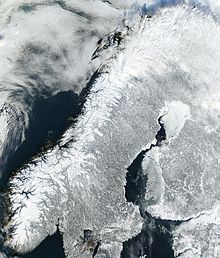
Norway comprises the western part of Scandinavia in Northern Europe. The rugged coastline, broken by huge fjords and thousands of islands, stretches 25,000 kilometres (16,000 mi) and 83,000 kilometres (52,000 mi) including fjords and islands. Norway shares a 1,619-kilometre (1,006 mi) land border with Sweden, 727 kilometres (452 mi) with Finland and 196 kilometres (122 mi) with Russia at the east. To the north, west and south, Norway is bordered by the Barents Sea, the Norwegian Sea, the North Sea and Skagerrak.
At 385,252 square kilometres (148,747 sq mi) (including Svalbard and Jan Mayen), (and 323,802 square kilometres (125,021 sq mi) without) much of the country is dominated by mountainous or high terrain, with a great variety of natural features caused by prehistoric glaciers and varied topography. The most noticeable of these are the fjords: deep grooves cut into the land flooded by the sea following the end of the Ice Age. The longest is Sognefjorden at 204 kilometres (127 mi). Sognefjorden is the world's second deepest fjord, and the world's longest. Hornindalsvatnet is the deepest lake in all Europe. Frozen ground all year can be found in the higher mountain areas and in the interior of Finnmark county. Numerous glaciers are found in Norway.
Norway lies between latitudes 57° and 81° N, and longitudes 4° and 32° E.
The land is mostly made of hard granite and gneiss rock, but slate, sandstone and limestone are also common, and the lowest elevations contain marine deposits. Because of the Gulf Stream and prevailing westerlies, Norway experiences higher temperatures and more precipitation than expected at such northern latitudes, especially along the coast. The mainland experiences four distinct seasons, with colder winters and less precipitation inland. The northernmost part has a mostly maritime Subarctic climate, while Svalbard has an Arctic tundra climate.
Because of the large latitudinal range of the country and the varied topography and climate, Norway has a larger number of different habitats than almost any other European country. There are approximately 60,000 species in Norway and adjacent waters (excluding bacteria and virus). The Norwegian Shelf large marine ecosystem is considered highly productive.
Climate
The southern and western parts of Norway experience more precipitation and have milder winters than the southeastern part. The lowlands around Oslo have the warmest and sunniest summers but also cold weather and snow in wintertime (especially inland).
Because of Norway's high latitude, there are large seasonal variations in daylight. From late May to late July, the sun never completely descends beneath the horizon in areas north of the Arctic Circle (hence Norway's description as the "Land of the Midnight Sun"), and the rest of the country experiences up to 20 hours of daylight per day. Conversely, from late November to late January, the sun never rises above the horizon in the north, and daylight hours are very short in the rest of the country.
Biodiversity
The total number of species include 16,000 species of insects (probably 4,000 more species yet to be described), 20,000 species of algae, 1,800 species of lichen, 1,050 species of mosses, 2,800 species of vascular plants, up to 7,000 species of fungi, 450 species of birds (250 species nesting in Norway), 90 species of mammals, 45 fresh-water species of fish, 150 salt-water species of fish, 1,000 species of fresh-water invertebrates and 3,500 species of salt-water invertebrates. About 40,000 of these species have been described by science. The red list of 2010 encompasses 4,599 species.
Seventeen species are listed mainly because they are endangered on a global scale, such as the European beaver, even if the population in Norway is not seen as endangered. The number of threatened and near-threatened species equals to 3,682; it includes 418 fungi species, many of which are closely associated with the small remaining areas of old-growth forests, 36 bird species, and 16 species of mammals. As of 2010, 2,398 species were listed as endangered or vulnerable; of these are 1250 listed as vulnerable (VU), 871 as endangered (EN), and 276 species as critically endangered (CR), among these are the gray wolf, the Arctic fox (healthy population on Svalbard) and the pool frog.
The largest predator in Norwegian waters is the sperm whale, and the largest fish is the basking shark. The largest predator on land is the polar bear, while the brown bear is the largest predator on the Norwegian mainland, where the common moose (also known as the "European Elk") is the largest animal.
Environment
Stunning and dramatic scenery and landscape is found throughout Norway. The west coast of southern Norway and the coast of northern Norway present some of the most visually impressive coastal sceneries in the world. National Geographic has listed the Norwegian fjords as the world's top tourist attraction. The 2012 Environmental Performance Index put Norway in third place, based on the environmental performance of the country's policies.
-
Rondeslottet in Rondane National Park, Eastern Norway
Politics
According to the Constitution of Norway, which was adopted on 16 May 1814 and inspired by the United States Declaration of Independence and French Revolution of 1776 and 1789, respectively, Norway is a unitary constitutional monarchy with a parliamentary system of government, wherein the King of Norway is the head of state and the Prime Minister is the head of government. Power is separated between the legislative, executive and judicial branches of government, as defined by the Constitution, which serves as the country's supreme legal document.
The Monarch officially retains executive power, however, following the introduction of a parliamentary system of government, the duties of the Monarch have since become strictly representative and ceremonial, such as the formal appointment and dismissal of the Prime Minister and other ministers in the executive government. Accordingly, the Monarch is commander-in-chief of the Norwegian armed forces, and serves as chief diplomatic official abroad and a symbol of unity.
In practice, it is the Prime Minister who is responsible for the exercise of executive powers. Since his accession in 1991, Harald V of the House of Schleswig-Holstein-Sonderburg-Glücksburg has been King of Norway, the first since the 14th century who has actually been born in the country. Haakon, Crown Prince of Norway is the legal and rightful heir to the throne and the Kingdom.
Constitutionally, legislative power is vested with both the government and the Parliament of Norway, but the latter is the supreme legislature and a unicameral body. A proposition can become a law or an act by simple majority among the 150 representatives, who are elected on the basis of proportional representation from 19 constituencies for four-year terms. An additional 19 seats ("levelling seats") are allocated on a nationwide basis to make the representation in parliament correspond better with the popular vote.
As a result, there are currently 169 Members of Parliament altogether. There is also a 4% election threshold to gain levelling seats in Parliament. As such, Norway is fundamentally structured as a representative democracy. Effectively called the Stortinget, meaning Grand Assembly, members of Parliament ratify treaties and can impeach members of the government if their acts are declared unconstitutional, and as such have the power to remove them from office in case of an impeachment trial.
The position of Prime Minister, Norway's head of government, is allocated to the Member of Parliament who can obtain the confidence of a majority in Parliament, usually the current leader of the largest political party or more effectively through a coalition of parties, as a single party normally does not have the support to form a government on its own. However, Norway has often been ruled by minority governments.
The Prime Minister nominates the Cabinet, traditionally drawn from members of the same political party in the Storting, to which they are responsible, and as such forms the executive government and exercises power vested to them by the Constitution. In order to form a government, however, more than half the membership of the Cabinet is required to belong to the Church of Norway. Currently, this means at least ten out of the 19 ministries. This has sparked controversy regarding an ongoing debate of separation of church and state in Norway. The current Prime Minister is Jens Stoltenberg, the leader of the Norwegian Labour Party (AP).
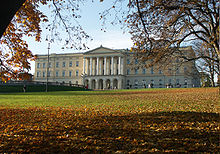
Through the Council of State, a privy council presided over by the Monarch, the Prime Minister and the Cabinet meet at the Royal Palace and formally consult the Monarch. Besides enacting parliamentary bills, all government bills need the formal approval by the Monarch before and after introduction to Parliament. Approval is also given by the Council to all of the Monarch's actions as head of state. Although all government and parliamentary acts are decided beforehand, the privy council is an example of another symbolic gesture the King obtains.
Members of the Storting are directly elected from party-lists proportional representation in nineteen plural-member constituencies in a national multi-party system. Historically, both the Norwegian Labour Party and Conservative Party have played leading political roles, while the former has remained in power since the 2005 election, in a Red-Green Coalition with the Socialist Left Party and the Centre Party.
Since then, both the Conservative Party and the Progress Party have won great amount of seats in the Parliament, however, as of the 2009 general election, not sufficient enough to overthrow the coalition. This has been the result of poor cooperation between the opposition parties, including the Liberal Party and the Christian Democratic Party. As such, Jens Stoltenberg, the leader of the Labour Party, remains Prime Minister of Norway with the necessary majority attributed to the alliance with the Socialist Left and Centre parties.
Administrative divisions
Norway, a unitary state, is divided into nineteen first-level administrative counties (fylker). The counties are administrated through directly elected county assemblies who elect the County Governor. Additionally, the King and government are represented in every county by a fylkesmann, who effectively acts as a Governor. As such, the Government is directly represented at a local level through the County Governors' offices. The counties are then sub-divided into 430 second-level municipalities (kommuner), which in turn are administrated by directly elected municipal council, headed by a mayor and a small executive cabinet. The capital of Oslo is considered both a county and a municipality. Norway also has two integral overseas territories, Jan Mayen and Svalbard. There are three Antarctic and Subantarctic dependencies: Bouvet Island, Peter I Island and Queen Maud Land.
In addition, there are 96 settlements with city status in Norway. In most cases, the city borders are coterminous with the borders of their respective municipalities. Often, Norwegian city municipalities include large areas that are not built up; for example, Oslo municipality contains large forests, located north and southeast of the city, and over half of Bergen municipality consists of mountainous areas.
The counties of Norway are:
| County (fylke) | Administrative centre | Most populous municipality |
|---|---|---|
| |
Sarpsborg | Fredrikstad |
| |
Oslo | Bærum |
| City of Oslo | Oslo | |
| |
Hamar | Ringsaker |
| |
Lillehammer | Gjøvik |
| |
Drammen | Drammen |
| |
Tønsberg | Sandefjord |
| |
Skien | Skien |
| |
Arendal | Arendal |
| |
Kristiansand | Kristiansand |
| |
Stavanger | Stavanger |
| |
Bergen | Bergen |
| |
Leikanger | Førde |
| |
Molde | Ålesund |
| |
Trondheim | Trondheim |
| |
Steinkjer | Stjørdal |
| |
Bodø | Bodø |
| |
Tromsø | Tromsø |
| |
Vadsø | Alta |
Judicial system and law enforcement
Norway uses a civil law system where laws are created and amended in Parliament and the system regulated through the Courts of Justice of Norway. It consists of the Supreme Court of 19 permanent judges and a Chief Justice, appellate courts, city and district courts, and conciliation councils. The judiciary is independent of executive and legislative branches. While the Prime Minister nominates Supreme Court Justices for office, their nomination must be approved by Parliament and formally confirmed by the Monarch in the Council of State. Usually, judges attached to regular courts are formally appointed by the Monarch on the advice of the Prime Minister.
The Courts' strict and formal mission is to regulate the Norwegian judicial system, interpret the Constitution, and as such implement the legislation adopted by Parliament and monitor the legislative and executive powers to ensure that they themselves comply with the acts of legislation that have been previously adopted.
Law enforcement in Norway is carried out by the Norwegian Police Service. The Norwegian Police Service is a Unified National Police Service made up of 27 Police Districts and several specialist agencies like Økokrim and the National Criminal Investigation Service, each headed by a chief of police. The Police Service is headed by the National Police Directorate, which in turn is subordinate to the Ministry of Justice and the Police, the Police Directorate is headed by a National Police Commissioner. The only exception is the Norwegian Police Security Agency who answers directly to the Ministry of Justice and the Police.
In its 2007 Worldwide Press Freedom Index, Reporters Without Borders ranked Norway at a shared 1st place (with Iceland) out of 169 countries. The death penalty was abolished in Norway in 1902. Death penalty for high treason in war and war-crimes was also abolished in 1979.
Foreign relations
Norway maintains embassies in 86 countries. 60 countries maintain an embassy in Norway, all of them in the capital, Oslo.
Norway is a founding member of the United Nations (UN), the North Atlantic Treaty Organization (NATO), the Council of Europe and the European Free Trade Association (EFTA). Norway issued applications for accession to the European Union (EU) and its predecessors in 1962, 1967 and 1992, respectively. While Denmark, Sweden and Finland obtained membership, the treaties of accession were rejected by the Norwegian electorate in 1972 and 1994. After the 1994 referendum, Norway maintained its membership in the European Economic Area (EEA), an arrangement granting the country access to the internal market of the Union, on the condition that Norway implements those of the Union's pieces of legislation which are deemed relevant (counting approximately seven thousand as of 2010) Successive Norwegian governments have, since 1994, requested Norway's participation in parts of the EU's cooperation which go beyond the provisions of the EEA agreement. Non-voting participation by Norway has been granted in for instance the Union's Common Security and Defence Policy, the Schengen Agreement, the European Defence Agency as well as 19 separate programmes.
Norway has made a contribution in international development, and was involved in the 1990s brokering which lead to the ill-fated Oslo Accords regarding the Israeli–Palestinian conflict.
Military
The Norwegian Armed Forces currently numbers about 23,000 personnel, including civilian employees. According to the current (as of 2009) mobilization plans, the strength during full mobilization is approximately 83,000 combatant personnel. Norway has conscription for males (6–12 months of training) and voluntary service for females. The Armed Forces are subordinate to the Norwegian Ministry of Defence and the Commander-in-Chief is King Harald V. The military of Norway is divided into the following branches: the Army, the Royal Navy, the Royal Air Force and the Home Guard.
Partly due to Norway's inability to maintain its traditional policy of neutrality in World War II (joining the Allied war effort after being invaded by Nazi Germany in April 1940), the country was one of the founding nations of the North Atlantic Treaty Organization (NATO) on 4 April 1949. At present, Norway contributes in the International Security Assistance Force (ISAF) in Afghanistan. Additionally, Norway has contributed in several missions in contexts of the United Nations, NATO, and the Common Security and Defence Policy of the European Union.
Economy
Norwegians enjoy the second highest GDP per-capita (after Luxembourg) and fourth highest GDP (PPP) per-capita in the world. Today, Norway ranks as the second wealthiest country in the world in monetary value, with the largest capital reserve per capita of any nation. According to the CIA World Factbook, Norway is a net external creditor of debt. Norway maintained first place in the world in the UNDP Human Development Index (HDI) for six consecutive years (2001–2006), and then reclaimed this position in 2009 and 2010. The standard of living in Norway is among the highest in the world. Foreign Policy Magazine ranks Norway last in its Failed States Index for 2009, judging Norway to be the world's most well-functioning and stable country. Continued oil and gas exports coupled with a healthy economy and substantial accumulated wealth lead to a conclusion that Norway will remain among the richest countries in the world in the foreseeable future.
The Norwegian economy is an example of a mixed economy, a prosperous capitalist welfare state featuring a combination of free market activity and large state ownership in certain key sectors. The Norwegian welfare state makes public health care free (above a certain level), and parents have 46 weeks paid parental leave. The income that the state receives from natural resources includes a significant contribution from petroleum production and the substantial and carefully managed income related to this sector. Norway has a very low unemployment rate, currently 2.6%. 30% of the labour force are employed by the government, the highest in the OECD. The hourly productivity levels, as well as average hourly wages in Norway are among the highest in the world. The egalitarian values of the Norwegian society ensure that the wage difference between the lowest paid worker and the CEO of most companies is much smaller than in comparable western economies. This is also evident in Norway's low Gini coefficient. The state has large ownership positions in key industrial sectors, such as the strategic petroleum sector ( Statoil and Aker Solutions), hydroelectric energy production ( Statkraft), aluminium production ( Norsk Hydro), the largest Norwegian bank ( DnB NOR), and telecommunication provider ( Telenor). Through these big companies, the government controls approximately 30% of the stock values at the Oslo Stock Exchange. When non-listed companies are included, the state has even higher share in ownership (mainly from direct oil license ownership). Norway is a major shipping nation and has the world's 6th largest merchant fleet, with 1,412 Norwegian-owned merchant vessels.
Referendums in 1972 and 1994 indicated that the Norwegian people wished to remain outside the European Union (EU). However, Norway, together with Iceland and Liechtenstein, participates in the European Union's single market via the European Economic Area (EEA) agreement. The EEA Treaty between the European Union countries and the EFTA countries– transposed into Norwegian law via "EØS-loven"– describes the procedures for implementing European Union rules in Norway and the other EFTA countries. This makes Norway a highly integrated member of most sectors of the EU internal market. However, some sectors, such as agriculture, oil and fish, are not wholly covered by the EEA Treaty. Norway has also acceded to the Schengen Agreement and several other intergovernmental agreements between the EU member states.
The country is richly endowed with natural resources including petroleum, hydropower, fish, forests, and minerals. Large reserves of petroleum and natural gas were discovered in the 1960s, which led to a boom in the economy. Norway has obtained one of the highest standards of living in the world in part by having a large amount of natural resources compared to the size of the population. In 2011, 28% of state revenues were generated from the petroleum industry.
Transport
Due to the low population density, narrow shape and long coastlines, public transport in Norway is less developed than in many European countries, especially outside the cities. As such, Norway has old water transport traditions, but the Norwegian Ministry of Transport and Communications has in recent years implemented rail, road and air transport through numerous subsidiaries in order to develop the country's infrastructure. Most recently there has been discussion of the possibility of creating a new high-speed rail system between the nation's largest cities.
Norway's main railway network consists of 4,114 kilometres (2,556 mi) of standard gauge lines, of which 242 kilometres (150 mi) is double track and 64 kilometres (40 mi) high-speed rail (210 km/h) while 62% is electrified at 15 kV 16⅔ Hz AC. The railways transported 56,827,000 passengers 2,956 million passenger kilometres and 24,783,000 tonnes of cargo 3,414 million tonne kilometres. The entire network is owned by the Norwegian National Rail Administration, while all domestic passenger trains except the Airport Express Train are operated by Norges Statsbaner (NSB). Several companies operate freight trains.
Investment in new infrastructure and maintenance is financed through the state budget, and subsidies are provided for passenger train operations. NSB operates long-haul trains, including night trains, regional services and four commuter train systems, around Oslo, Trondheim, Bergen and Stavanger.
There are approximately 92,946 kilometres (57,754 mi) of road network in Norway, of which 72,033 kilometres (44,759 mi) are paved and 664 kilometres (413 mi) are motorway. There are four tiers of road routes; national, county, municipal and private, with only the national roads numbered en route. The most important national routes are part of the European route scheme, and the two most prominent are the E6 going north-south through the entire country, while E39 follows the West Coast. National and county roads are managed by the Norwegian Public Roads Administration.
Of the 97 airports in Norway, 52 are public, and 46 are operated by the state-owned Avinor. Seven airports have more than one million passengers annually. 41,089,675 passengers passed through Norwegian airports in 2007, of which 13,397,458 were international.
The central gateway by air to Norway is Oslo Airport, Gardermoen, located about 50 kilometres (31 mi) north of Oslo with departures to most European countries and some intercontinental destinations. It is hub for the two major Norwegian airlines Scandinavian Airlines System and Norwegian Air Shuttle, and for regional aircraft from Western Norway.
Demographics
| Historical population | ||
|---|---|---|
| Year | Pop. | ±% |
| 1500 | 140,000 | — |
| 1665 | 440,000 | +214.3% |
| 1735 | 616,109 | +40.0% |
| 1801 | 883,603 | +43.4% |
| 1855 | 1,490,047 | +68.6% |
| 1900 | 2,240,032 | +50.3% |
| 1950 | 3,278,546 | +46.4% |
| 2000 | 4,478,497 | +36.6% |
| 2010 | 4,858,199 | +8.5% |
| 2012 | 5,003,218 | +3.0% |
| 2060? | 7,032,687 | +40.6% |
| Source: Statistics Norway. | ||
Norway's population was 5,051,300 people on 1 January 2013. Norwegians are North Germanic people.
The Sami people traditionally inhabit central and northern parts of Norway and Sweden, as well as in northern Finland and in Russia on the Kola Peninsula. Another national minority are the Kven people who are the descendants of Finnish speaking people that moved to northern Norway in the 18th up to the 20th century. Both the Sami and the Kven were subjected to a strong assimilation policy by the Norwegian government from the 19th century up to the 1970s. Because of this " Norwegianization process", many families of Sami or Kven ancestry now self-identify as ethnic Norwegian.
Other groups recognized as national minorities of Norway are Jews, Forest Finns, and Norwegian Romani Travellers (a branch of the Romani people, not to be confused with non-recognized Indigenous Norwegian Travellers).
14% of the Norwegian population are immigrants or children of two immigrant parents. About 6% of the immigrant population come from EU, North America and Australia, and about 8.1% come from Asia, Africa and Latin America.
Migration
Emigration
There are almost 4.7 million Norwegian Americans according to the 2006 U.S. census. The number of Americans of Norwegian descent living in the U.S. today is roughly equal to the current population of Norway. In the 2006 Canadian census, 432,515 Canadian citizens claimed Norwegian ancestry.
Immigration
As of 1 January 2013 the number of immigrants or children of two immigrants residing in Norway was 710,465, or 14.1% of the total population, up from 183,000 in 1992. Yearly immigration has increased rapidly since 2005. While yearly net immigration in 2001–2005 was on average 13,613, it increased to 37,541 in the period 2006–2010 and in 2011 net immigration reached 47,032. This is mostly due to increased immigration from the EU, in particular from Poland.
In 2012, the immigrant community (which includes immigrants and Norwegian-born children of immigrant parents) grew by 55,300, a record high. Net immigration from abroad reached 47,300 (300 higher than in 2011), while immigration accounted for 72% of Norway's population growth. 17% of newborn children were born to immigrant parents. and those with Pakistani, Somali and Vietnamese parents made up the largest groups of all Norwegian-born to immigrant parents.
Pakistani Norwegians are the largest non-European minority group in Norway, and most of their 32,700 members live around Oslo. The Iraqi and Somali immigrant populations have increased significantly in recent years. After the enlargement of the EU in 2004, there has also been an influx of immigrants from Central and Eastern Europe, particularly Poland. The fastest growing immigrant groups in 2011 in absolute numbers were from Poland, Lithuania and Sweden.
The policies of immigration and integration are subjected to much debate in Norway.
Largest immigrant groups (1st and 2nd generation):
| National background | Population |
|---|---|
| Poland | 82,601 |
| Sweden | 37,467 |
| Pakistan | 33,634 |
| Somalia | 33,117 |
| Lithuania | 30,540 |
| Iraq | 29,614 |
Religion
Most Norwegians are registered at baptism as members of the Church of Norway; many remain in the state church to be able to use services such as baptism, confirmation, marriage and burial, rites which have strong cultural standing in Norway. About 77.0% of Norwegians were members of the Church of Norway as of January 1, 2012. About 66% of all newborns were baptized and about 65% of all 15-year-old persons were confirmed in the church in 2011. However, only 20% of Norwegians say that religion occupies an important place in their life (according to a Gallup poll in 2009), the fourth-lowest such percentage in the world (only Estonia, Sweden and Denmark are lower). In the early 1990s, it was estimated that between 4.7% – 5.3% of Norwegians attended church on a weekly basis. This figure has dropped to about 2% – the lowest such percentage in Europe – according to 2009 and 2010 data
There were, by October 2012, about 115, 234 registered Catholics in Norway. It is estimated that total number of people with Catholic background may be 170,000-200, 000 or higher.
In 2010, 10% of the population was religiously unaffiliated, while another 9% (431 000 people), were members of religious and life stance communities outside the Church of Norway. Other Christian denominations total about 4.9% of the population, the largest of which is the Catholic Church, with 83,000 members. Others include Pentecostals (39,600), the Evangelical Lutheran Free Church of Norway (19,600), Methodists (11,000), Baptists (9,900), Orthodox (9,900) Brunstad Christian Church (6,800), Adventists (5,100), Assyrians and Chaldeans, and others. The Swedish, Finnish and Icelandic Lutheran congregations in Norway have about 27,500 members in total. Other religions comprise less than 1% each, including 4,000 members in the Church of Jesus Christ of Latter-day Saints, and 12,000 Jehovah's Witnesses.
Among non-Christian religions, Islam is the largest with the population of 106,735. It is practiced mainly by Somali, Arab, Albanian, and Turkish immigrants, as well as Norwegians of Pakistani descent. Other religions comprise less than 1% each, including 819 adherents of Judaism. Indian immigrants introduced Hinduism to Norway, which in 2011 has slightly more than 5,900 adherents, or 1% of non-Lutheran Norwegians. Sikhism has approximately 3,000 adherents with most living in Oslo, with two Gurdwaras; Gurdwara Sri Guru Nanak Dev Ji and Gurdwara Sikh Sangat. Sikhs first came to Norway in the early 1970s. The troubles in Punjab after Operation Blue Star and the genocide of Sikhs after the assassination of Indira Gandhi led to an increase of Sikhs moving to Norway. Drammen also has a sizeable population of Sikhs with the largest Gurdwara in north Europe completed in Lier. There are eleven Buddhist organizations, grouped under the Buddhistforbundet organization, with slightly over 14,000 members, which make up 0.2% of the population. The Baha'i religion has slightly more than 1,000 adherents. Around 1.7% (84,500) of Norwegians adhere to the secular Norwegian Humanist Association.
From 2006 to 2011, the fastest-growing religious faith in Norway was Orthodox Christianity, which grew in membership by 80.0%; however, its share of the total population remains small, at 0.20%. One of the reasons is huge immigration from Eritrea and Ethiopia and to a lesser extent from Eastern European and Middle Eastern countries. Other fast-growing religions were the Roman Catholic Church (78.7%), Hinduism (59.6%), Islam (48.1%), and Buddhism (46.7%).
Like other Scandinavian countries, the Norse followed a form of native Germanic paganism known as Norse paganism. By the end of the 11th century, when Norway had been Christianized, the indigenous Norse religion and practices were prohibited. Remnants of the native religion and beliefs of Norway survive today in the form of names, referential names of cities and locations, the days of the week, and other parts of the everyday language. Modern interest in the old ways has led to a revival of the pagan religious practices in the form of Asatru. The Norwegian Åsatrufellesskapet Bifrost formed in 1996; as of 2011, the fellowship has about 300 members. Foreningen Forn Sed formed in 1999 and has been recognized by the Norwegian government as a religious organization.
The Sami minority retained their shamanistic religion well into the 18th century when most of them were converted to Christianity by Dano-Norwegian missionaries. Today there is an increasing interest in the Sami way of life, which has led to a revival of Noaidevuohta (Sami Shamanism). There are also reports of Norwegian and Sami celebrities visiting Shamans for guidance. Although the majority of Sami people are Lutheran, there are some who managed to retain their ancient religion.
According to the Eurobarometer Poll 2005, at that time 32% of Norwegian citizens responded that "they believe there is a god". A study conducted three years previously by Gustafsson and Pettersson (2002), similarly found that 72% of Norwegians did not believe in a 'personal God.'
| Religion (as of 2012) | Members | Percent | Growth (2007–2012) | |
|---|---|---|---|---|
| Christianity | 4,120,213 | 82.6% | 0.5% | |
| Lutheranism | 3,884,037 | 77.9% | −0.8% | |
| Roman Catholicism | 102,286 | 2.1% | 98.6% | |
| Pentecostalism | 39,108 | 0.8% | −3.2% | |
| Jehovah's Witnesses | 11,903 | 0.2% | −19.3% | |
| Orthodox Christianity | 11,205 | 0.2% | 84.4% | |
| Methodism | 10,761 | 0.2% | −4.8% | |
| Baptists | 9,999 | 0.2% | 10.2% | |
| Smith's friends | 7,319 | 0.1% | 13.0% | |
| Seventh-day Adventist Church | 4,884 | 0.1% | −7.5% | |
| Other Christianity | 38,711 | 0.8% | 0.9% | |
| Non-Christian religions | 133,219 | 2.7% | 35.0% | |
| Islam | 112,236 | 2.3% | 41.9% | |
| Buddhism | 15,426 | 0.3% | 43.5% | |
| Hinduism | 5,690 | 0.1% | 38.8% | |
| Sikhism | 1,133 | 0.0% | −53.6% | |
| Bahá'í Faith | 1,088 | 0.0% | 7.2% | |
| Judaism | 153 | 0.0% | −82.4% | |
| Other religions | 1,218 | 0.0% | 178.1% | |
| Non-religious and unknown | 732,438 | 14.7% | 51.6% | |
| Humanism | 84,481 | 1.7% | 6.3% | |
| Total | 4,985,870 | 100.0% | 6.5% |
Urbanization
| Largest cities or towns of Norway According to Statistics Norway |
|||||||||
|---|---|---|---|---|---|---|---|---|---|
| Rank | City name | County | Pop. | Rank | City name | County | Pop. | ||
 Oslo |
1 | Oslo | Oslo | 925,242 | 11 | Ålesund | Møre og Romsdal | 48,460 |  Stavanger/Sandnes |
| 2 | Bergen | Hordaland | 238,098 | 12 | Haugesund | Rogaland | 44,524 | ||
| 3 | Stavanger/Sandnes | Rogaland | 201,353 | 13 | Moss | Østfold | 43,553 | ||
| 4 | Trondheim | Sør-Trøndelag | 167,598 | 14 | Sandefjord | Vestfold | 42,212 | ||
| 5 | Fredrikstad/Sarpsborg | Østfold | 105,545 | 15 | Bodø | Nordland | 38,326 | ||
| 6 | Drammen | Buskerud | 101,995 | 16 | Arendal | Aust-Agder | 33,778 | ||
| 7 | Porsgrunn/Skien | Telemark | 88,860 | 17 | Hamar | Hedmark | 30,921 | ||
| 8 | Kristiansand | Vest-Agder | 70,204 | 18 | Larvik | Vestfold | 24,422 | ||
| 9 | Tromsø | Troms | 57,015 | 19 | Halden | Østfold | 23,897 | ||
| 10 | Tønsberg | Vestfold | 49,093 | 20 | Lillehammer | Oppland | 20,857 | ||
Education
Higher education in Norway is offered by a range of seven universities, five specialized colleges, 25 university colleges as well as a range of private colleges. Education follows the Bologna Process involving Bachelor (3 years), Master (2 years) and PhD (3 years) degrees. Acceptance is offered after finishing upper secondary school with general study competence.
Public education is virtually free, regardless of nationality, with an academic year with two semesters, from August to December and from January to June. The ultimate responsibility for the education lies with the Norwegian Ministry of Education and Research.
Languages
The North Germanic Norwegian language has two official written forms, Bokmål and Nynorsk. Both of them are recognized as official languages, in that they are both used in public administration, in schools, churches, and media, and Bokmål is the written language used by the vast majority of about 80–85%. Around 95% of the population speak Norwegian as their native language, although many speak dialects that may differ significantly from the written language. All Norwegian dialects are inter-intelligible, although listeners with very limited exposure to dialects other than their own may struggle to understand certain phrases and pronunciations in some other dialects. Several Uralic Sami languages are spoken and written throughout the country, especially in the north, by some members of the Sami people (estimates suggest about one third of Norwegian Sami speak a Sami language). Speakers have a right to get education in Sami language no matter where they are living and to receive communication from the government in various Sami languages. The Kven minority historically spoke the Uralic Kven language (considered a separate language in Norway, but generally perceived as a Finnish dialect in Finland), but the majority of Kvens today have little or no knowledge of the language. According to the Kainun institutti "The typical modern Kven is a Norwegian-speaking Norwegian who knows his genealogy". There is advocacy for making Norwegian Sign Language an official Norwegian language.
In the 19th and 20th century, Norwegian language was subject to strong political and cultural controversy, which led to the creation of Nynorsk in the 19th century and to the formation of alternative spelling standards in the 20th century, notably the Riksmål standard, which is more conservative (that is, more similar to Danish) than Bokmål.
Norwegian is similar to the other languages in Scandinavia, Swedish and Danish. All three languages are mutually intelligible and can be, and commonly are, employed in communication between inhabitants of the Scandinavian countries. As a result of the cooperation within the Nordic Council, inhabitants of all Nordic countries, including Iceland and Finland, have the right to communicate with the Norwegian authorities in their own language.
Any Norwegian student who is a child of immigrant parents is encouraged to learn the Norwegian language. The Norwegian government offers language instructional courses for immigrants wishing to obtain Norwegian citizenship. From 1 September 2008, an applicant for Norwegian citizenship must also give evidence of proficiency in either the Norwegian or Sami language or give proof of having attended classes in Norwegian for 300 hours, or meet the language requirements for university studies in Norway (which is met by being proficient in one of the Scandinavian languages).
The main foreign language taught in Norwegian elementary school is English. The majority of the population are fluent in English, especially those born after World War II. German, French and Spanish are also commonly taught as a second or, more often, third language. Russian, Japanese, Italian, Latin, and rarely Chinese (Mandarin) are available in some schools, mostly in the cities. Traditionally, English, German and French were considered the main foreign languages in Norway. These languages, for instance, had been used on Norwegian passports until the 1990s, and university students have a general right to use these languages when submitting their theses.
Culture
The Norwegian farm culture continues to play a role in contemporary Norwegian culture. In the 18th century, it brought about a strong romantic nationalistic movement, which is still visible in the Norwegian language and media. In the 19th century, Norwegian culture blossomed as efforts continued to achieve an independent identity in the areas of literature, art and music. This continues today in the performing arts and as a result of government support for exhibitions, cultural projects and artwork.
Norway has been, in many regards, an early adopter of women's rights, minority rights, and LGBT rights. As early as 1884, 171 of the leading personalities of the day, among them five Prime Ministers for the Liberal Party and the Conservative Party, co-founded the Norwegian Association for Women's Rights, and they successfully campaigned for women's right to education, women's suffrage, the right to work and other gender equality policies. From the 1970s, gender equality also came high on the state agenda with the establishment of a public body to promote gender equality.
In 1990 Norway was the first country to recognize the ILO-convention 169 on indigenous people. In regard to LGBT rights, Norway was the first country in the world to enact an anti-discrimination law protecting the rights of gays and lesbians. In 1993 Norway became the second country to legalize civil union partnerships for same-sex couples, and on January 1, 2009, Norway became the sixth country to grant full marriage equality to same-sex couples.
However, only in 1990 was the Norwegian constitution altered to grant absolute primogeniture to the Norwegian throne, meaning that the eldest child, regardless of gender, takes precedence in the line of succession. This was not done retroactively, meaning that even now the current successor to the throne is not the eldest child to the King, but the eldest son. The Norwegian constitution Article 6 states that "For those born before the year 1990 it shall...be the case that a male shall take precedence over a female."
An ardent promoter of human rights, Norway is home to the annual Oslo Freedom Forum conference, a gathering described by The Economist as "on its way to becoming a human-rights equivalent of the Davos economic forum."
Cinema
Not until fairly recently has the Norwegian cinema received international recognition, but as early as 1951 a documentary film of the Kon-Tiki expedition won an Oscar Academy Award. In 1959, Arne Skouen's Nine Lives was nominated, but failed to win. Another notable film is Flåklypa Grand Prix (English: Pinchcliffe Grand Prix), an animated feature film directed by Ivo Caprino. The film was released in 1975 and is based on characters from Norwegian cartoonist Kjell Aukrust. It is the most widely seen Norwegian film of all time.
There was however a real breakthrough in 1987 with Nils Gaup's Pathfinder which told the story of the Sami. It was nominated for an Oscar and was a huge international success. Berit Nesheim's The Other Side of Sunday was also nominated for an Oscar in 1997.
Since the 1990s, the film industry has thrived with up to 20 feature films each year. Particular successes were Kristin Lavransdatter, The Telegraphist and Gurin with the Foxtail. Knut Erik Jensen was among the more successful new directors together with Erik Skjoldbjærg remembered for Insomnia.
In late 2008, the movie Max Manus opened at Norwegian theatres. The movie was a WW2 drama, telling the story of the Norwegian resistance hero Max Manus who led many successful sabotage operations against the German occupation. The movie became the highest grossing Norwegian movie ever.
Other notable successful Norwegian films include Orion's Belt, Cold Prey, Cold Prey 2, Cold Prey 3 and The Troll Hunter.
The country has also been used as filming location for several Hollywood and other international productions, including the 1980 movie Star Wars Episode V: The Empire Strikes Back where the producers used Hardangerjøkulen glacier as a filming location, for scenes of the ice planet Hoth, including a memorable battle in the snow. Other films include scenes from the James Bond film Die Another Day, The Golden Compass, Spies Like Us and Heroes of Telemark as well as the TV series Lilyhammer.
Music
Along with the classical music of romantic composers Edvard Grieg; Rikard Nordraak and Johan Svendsen, and the modern music of Arne Nordheim, Norwegian black metal has become something of an export article in recent years.
Norway's classical performers include Leif Ove Andsnes, one of the world's more famous pianists, Truls Mørk, an outstanding cellist, and the great Wagnerian soprano Kirsten Flagstad.
Since the 1990s, Norway's biggest cultural export is black metal. The lo-fi, dark and raw form of heavy metal exploded in Norway during the 1990s and launched the careers of bands such as Darkthrone, Mayhem, Burzum, Emperor, Gorgoroth and Immortal, as well as later bands such as Dimmu Borgir. This development has since become an important part of extreme metal, but many events that took place in the early 1990s related to the black metal movement such as several church burnings and a prominent murder case caused some concern among the Norwegian citizens at large.
The jazz scene in Norway is also thriving. Jan Garbarek, Terje Rypdal, Mari Boine, Arild Andersen, and Bugge Wesseltoft are internationally recognized while Paal Nilssen-Love, Supersilent, Jaga Jazzist and Wibutee are becoming world-class artists of the younger generation.
Norway has a strong folk music tradition which remains popular to this day. Among the most prominent folk musicians are Hardanger fiddlers Andrea Een, Olav Jørgen Hegge and Annbjørg Lien, vocalists Agnes Buen Garnås, Kirsten Bråten Berg and Odd Nordstoga.
Other internationally recognized bands are A-ha and Röyksopp. A-ha initially rose to global fame during the mid-1980s. In the 1990s and 2000s the group maintained its popularity domestically, and saw some success outside Norway (mainly in Germany and Switzerland).
In recent years, various Norwegian songwriters and production teams have contributed to other international artists releases. Most notably the Norwegian production team Stargate (production team) has produced songs for Rihanna, Beyoncé Knowles, Shakira, Jennifer Lopez and Lionel Richie among others. Espen Lind has written and produced songs for Beyoncé Knowles, Lionel Richie, Ne-Yo, Chris Brown, Jessica Simpson and Leona Lewis. Lene Marlin has written songs for Rihanna and Lovebugs
Norway enjoys many music festivals throughout the year, all over the country. Norway is the host of one of the world's biggest Extreme sport festivals with music; Ekstremsportveko – a festival held annually in Voss. Oslo is the host of many festivals, such as: Øyafestivalen and by:Larm. Oslo used to have a summerparade similar to the German Love Parade. In 1992 the city of Oslo wanted to adopt the French music festival "Fête de la Musique". Fredrik Carl Størmer established the festival. Even in its first year, "Musikkens Dag" gathered thousands of people and artists in the streets of Oslo. "Musikkens Dag" is now renamed "Musikkfest Oslo. Norway also have a festival named trænafestivalen each year on the island Træna.
Literature
History of Norwegian literature starts with the pagan Eddaic poems and skaldic verse of the 9th and 10th centuries with poets such as Bragi Boddason and Eyvindr skáldaspillir. The arrival of Christianity around the year 1000 brought Norway into contact with European mediaeval learning, hagiography and history writing. Merged with native oral tradition and Icelandic influence this was to flower into an active period of literature production in the late 12th and early 13th centuries. Major works of that period include Historia Norwegiæ, Þiðrekssaga and Konungs skuggsjá.
Little Norwegian literature came out of the period of the Scandinavian Union and the subsequent Dano-Norwegian union (1387—1814), with some notable exceptions such as Petter Dass and Ludvig Holberg. In his play Peer Gynt, Ibsen characterized this period as "Twice two hundred years of darkness/brooded o'er the race of monkeys", although the latter line is not as frequently quoted as the former. During the union with Denmark, written Norwegian was replaced by Danish.
Two major events precipitated a major resurgence in Norwegian literature. In 1811 a Norwegian university was established in Christiania. Seized by the spirit of revolution following the American and French Revolutions, the Norwegians signed their first Constitution in 1814. Soon, the cultural backwater that was Norway brought forth a series of strong authors recognized first in Scandinavia, and then worldwide; among them were Henrik Wergeland, Peter Christen Asbjørnsen, Jørgen Moe and Camilla Collett.
By the late 19th century, in the Golden Age of Norwegian literature, the so-called Great Four emerged: Henrik Ibsen, Bjørnstjerne Bjørnson, Alexander Kielland, and Jonas Lie. Bjørnson's "peasant novels", such as "En glad gutt" (A Happy Boy) and "Synnøve Solbakken" are typical of the national romanticism of their day, whereas Kielland's novels and short stories are mostly realistic. Although an important contributor to early Norwegian romantic nationalism (especially the ironic Peer Gynt), Henrik Ibsen's fame rests primarily on his pioneering realistic dramas such The Wild Duck and A Doll's House, many of which caused moral uproar because of their candid portrayals of the middle classes.
In the 20th century, three Norwegian novelists were awarded the Nobel Prize in Literature: Bjørnstjerne Bjørnson in 1903, Knut Hamsun for the book " Markens grøde" ("Growth of the Soil") in 1920, and Sigrid Undset in 1928. Further important contributions to Norwegian literature were made by writers like Dag Solstad, Jon Fosse, Cora Sandel, Olav Duun, Olav H. Hauge, Gunvor Hofmo, Stein Mehren, Kjell Askildsen, Hans Herbjørnsrud, Aksel Sandemose, Bergljot Hobæk Haff, Jostein Gaarder, Erik Fosnes Hansen, Jens Bjørneboe, Kjartan Fløgstad, Lars Saabye Christensen, Johan Borgen, Herbjørg Wassmo, Jan Erik Vold, Rolf Jacobsen, Olaf Bull, Jan Kjærstad, Georg Johannesen, Tarjei Vesaas, Sigurd Hoel, Arnulf Øverland and Johan Falkberget.
Research
Internationally recognized Norwegian scientists include mathematician Niels Henrik Abel, for whom the Abel Prize has been named. Ludvig Holberg was noted not only as a writer, but also as a philosopher, historian and legal theorist.
In the 20th century, Norwegian academics have been pioneering in many social sciences, including criminology, sociology and peace and conflict studies. Prominent academics include philosopher and founder of deep ecology Arne Næss, the founder of peace studies Johan Galtung, criminologists Nils Christie and Thomas Mathiesen, social anthropologist Fredrik Barth, sociologists Vilhelm Aubert, Harriet Holter and Erik Grønseth, women's law pioneer Tove Stang Dahl, political scientist Stein Rokkan, and economist Ragnar Frisch.
Architecture
Norway has always had a tradition of building in wood. Indeed, many of today's most interesting new buildings are made of wood, reflecting the strong appeal that this material continues to hold for Norwegian designers and builders.
Norway's conversion to Christianity some 1,000 years ago led to the introduction of stonework architecture, beginning with the construction of Nidaros Cathedral in Trondheim.
In the early Middle Ages, stave churches were constructed throughout Norway. Many of them remain to this day and represent Norway's most important contribution to architectural history. A fine example is Urnes Stave Church which is now on UNESCO's World Heritage List. Another notable example of wooden architecture is the Bryggen Wharf in Bergen, consisting of a row of narrow wooden structures along the quayside.
In the 17th century, under the Danish monarchy, cities such as Kongsberg with its Baroque church and Røros with its wooden buildings were established.
After Norway's union with Denmark was dissolved in 1814, Oslo became the capital. Architect Christian H. Grosch designed the oldest parts of the University of Oslo, the Oslo Stock Exchange, and many other buildings and churches.
At the beginning of the 20th century, the city of Ålesund was rebuilt in the Art Nouveau style. The 1930s, when functionalism dominated, became a strong period for Norwegian architecture, but it is only in recent decades that Norwegian architects have truly achieved international renown. One of the most striking modern buildings in Norway is the Sami Parliament in Kárášjohka designed by Stein Halvorson and Christian Sundby. Its debating chamber is an abstract timber version of a Lavvo, the traditional tent used by the nomadic Sami people.
Art
For an extended period, the Norwegian art scene was dominated by artwork from Germany and Holland as well as by the influence of Copenhagen. It was in the 19th century that a truly Norwegian era began, first with portraits, later with even more impressive landscapes. Johan Christian Dahl (1788–1857), originally from the Dresden school, eventually returned to paint the landscapes of western Norway, defining Norwegian painting for the first time."
Norway's newly found independence from Denmark encouraged painters to develop their Norwegian identity, especially with landscape painting by artists such as Kitty Kielland, a female painter who studied under Hans Gude; Harriet Backer, 1845–1932, another pioneer among female artists, influenced by impressionism. Frits Thaulow, an impressionist, was influenced by the art scene in Paris as was Christian Krohg, a realist painter, famous for his paintings of prostitutes.
Of particular note is Edvard Munch, a symbolist/expressionist painter who became world famous for The Scream which is said to represent the anxiety of modern man.
Other artists of note include Harald Sohlberg, a neo-romantic painter remembered for his paintings of Røros; and Odd Nerdrum, a figurative painter who maintains his work is not art but kitsch.
Cuisine
Norway's culinary traditions show the influence of long seafaring and farming traditions with salmon (fresh and cured), herring (pickled or marinated), trout, codfish and other seafood balanced by cheeses, dairy products and breads (predominantly dark/darker).
Lefse is a Norwegian potato flatbread, usually topped with large amounts of butter and sugar, most common around Christmas. Some traditional Norwegian dishes include lutefisk, smalahove, pinnekjøtt and fårikål.
Sport
Norway first participated at the Olympic Games in 1900, and has sent athletes to compete in every Games since then, except for the sparsely attended 1904 Games and the 1980 Summer Olympics in Moscow when they participated in the American-led boycott.
Norway has hosted the Games on two occasions:
- 1952 Winter Olympics in Oslo
- 1994 Winter Olympics in Lillehammer
Football is the most popular sport in Norway in terms of active membership (by television viewership football comes third, behind biathlon and cross-country skiing).


![Location of Norway (dark green)in Europe (dark grey) — [Legend]](../../images/856/85617.png)
